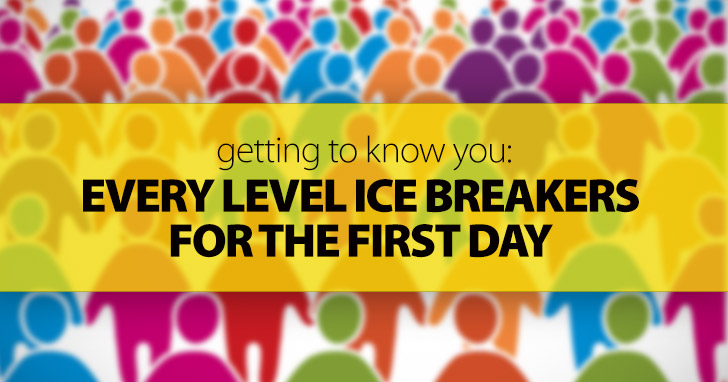7 Easy Icebreakers You Can Do With Post-It Notes


Your students will be working together for the rest of the semester, and the sooner they get to know each other, the more supportive and encouraging they can be. Some icebreakers, though, are better for beginning students while others are best for advanced students. Here are some activities you can use with your students no matter what level you are teaching.

Keeping icebreakers simple for beginning students will get your class off to a stress free start, and this ice breaker is one of the simplest. Write a list of simple get to know you questions (Do you like sports? What is your favorite song? What did you eat for breakfast? What time to you go to sleep? Etc.) Cut the questions into small strips and put them in a small jar. Students take turns choosing a piece of paper from the jar and answering the question. This activity also doubles as a fun way to review specific grammar points you will cover later in class. Just formulate your questions using the target grammatical structure and see if your students can answer with the correct grammar.
If you teach a class of internationals, this activity will help them get to know where their classmates are from. On a large map, have everyone put a small sticker where they are from. Once everyone has marked home, allow students to guess which sticker belongs to each person in your class.
This simple icebreaker matches each student (and you) to an unexpected fact. Have each person write a fun or unexpected fact about themself on a sticky note (I have a pet squirrel, for example). Collect all the sticky notes and put them on your front board. Students come up one at a time and point to a fact. They then guess who the fact describes. If they guess right, they keep the sticky note. If they guess incorrectly, they leave the note on the board. Students take turns until all the notes are gone. The person with the most notes in their possession at the end of the activity wins.

This simple icebreaker requires nothing other than personal creativity. Students prepare three statements about themselves – two that are true and one that is a lie. On her turn, a student shares her statements with her classmates, and they must guess which statement is the lie. This icebreaker even works with students who already know each other, as long as your students can come up with some really interesting facts about themselves.
This ice breaker will require a little preparation on your part, but after the initial investment you can use it year after year. On a blank Bingo board, fill in the boxes with phrases that might describe the people in your class: likes soccer, was born this month, has more than two siblings, speaks more than two languages, comes from the same home country as you, etc. (You can see some examples here.) Give each person a copy of the sheet. Then on your go, have students mingle and talk to each other, looking for someone who fits the description in one of the boxes. When they find someone who does, that person should sign their name in the box. When someone gets five boxes in a row, he calls Bingo and wins the round. If you like, play another round, but you will need a bingo board with different descriptions in the boxes to make the second round as challenging as the first.
Bring a big bag of M&Ms to class on the first day and pass them around, but tell your students to wait before they indulge. Once everyone has taken at least one candy, it’s time to get to know each other. Go around the room and give each person a chance to share about himself or herself. He will have to share one piece of information for every piece of candy he took. Some students may not have much to say if they only took a few pieces of candy. Others with a sweet tooth may end up sharing twenty or more pieces of information about themselves. After a student shares, he can enjoy his chocolate while listening to his classmates.

One of the greatest investments I ever made for my classroom was in a simple set of Jenga style stacking blocks. It’s a fun game and easy to play, but I wanted to add a language element and use it with my ESL students, so I wrote an icebreaker question on each block. I have groups of students play the game, and whatever block they pull, they have to answer the question on it. It’s a great way to learn about each other without putting a lot of pressure on students, and the game aspect gives us all something to enjoy while we are answering questions.
Would you rather always be late or always be early? Would you rather have only peanut butter or only jelly? Asking questions such as these is an easy way for students to get to know each other. Have your students stand up, give them a question, and have them go to opposite sides of the room based on their answer. Then choose a few volunteers to share why they made the choice they did. Though this is a simple icebreaker, students will have to be comfortable with the conditional structure to understand and answer appropriately, which is why it’s perfect for advanced students.
Advanced students should be comfortable talking with a classmate and getting to know them through conversation. Take things a step beyond this by having each person introduce his new friend to the rest of the class. Not only will your students get to know each other, you will also get a good chance to evaluate the speaking skills of your new students.
The first day of class can be fun and exciting, but it is also a good opportunity to get to know one another no matter what level you teach. These are just some of the activities you can do with your students on the first day to get the getting to know you started.